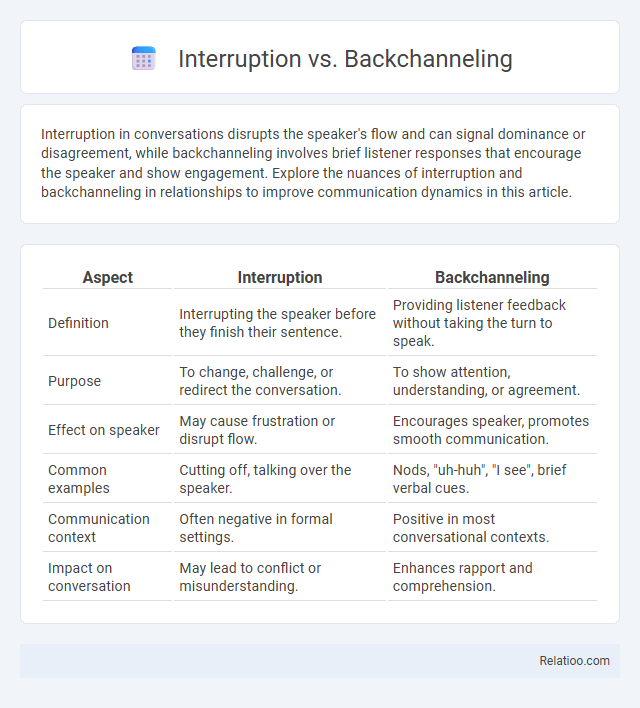Interruption in conversations disrupts the speaker's flow and can signal dominance or disagreement, while backchanneling involves brief listener responses that encourage the speaker and show engagement. Explore the nuances of interruption and backchanneling in relationships to improve communication dynamics in this article.
Table of Comparison
| Aspect | Interruption | Backchanneling |
|---|---|---|
| Definition | Interrupting the speaker before they finish their sentence. | Providing listener feedback without taking the turn to speak. |
| Purpose | To change, challenge, or redirect the conversation. | To show attention, understanding, or agreement. |
| Effect on speaker | May cause frustration or disrupt flow. | Encourages speaker, promotes smooth communication. |
| Common examples | Cutting off, talking over the speaker. | Nods, "uh-huh", "I see", brief verbal cues. |
| Communication context | Often negative in formal settings. | Positive in most conversational contexts. |
| Impact on conversation | May lead to conflict or misunderstanding. | Enhances rapport and comprehension. |
Definition of Interruption and Backchanneling
Interruption occurs when one speaker breaks or stops another speaker mid-sentence, shifting the conversation flow, often perceived as a dominance or control tactic. Backchanneling involves listeners providing feedback like "uh-huh," "I see," or nods to show engagement without taking the speaking turn, maintaining conversational flow. Your understanding of these conversational mechanisms enhances communication effectiveness and social interaction dynamics.
Key Differences Between Interruption and Backchanneling
Interruption involves actively breaking the speaker's turn to introduce new content or redirect the conversation, often signaling dominance or disagreement. Backchanneling, on the other hand, consists of brief verbal or nonverbal cues like "uh-huh" or nodding, which indicate attentiveness and encourage the speaker without taking the floor. Key differences lie in their conversational roles: interruption disrupts and takes over, while backchanneling supports and maintains the flow of communication.
The Role of Interruption in Conversation
Interruption plays a crucial role in conversation by signaling urgency, dominance, or emotional intensity, often shifting the speaker's control and direction of dialogue. Unlike backchanneling, which provides supportive listener feedback without overtaking the speaker's turn, interruptions actively break the flow to insert new information or challenge statements. Understanding interruption patterns reveals power dynamics and interaction styles, highlighting how conversational control impacts communication effectiveness.
Positive and Negative Effects of Interruption
Interruption can disrupt communication, causing misunderstandings and frustration, yet it may also signal engagement or assertiveness in conversations. Backchanneling, such as nodding or verbal affirmations, typically facilitates smoother interactions by providing feedback without overtaking the speaker. The positive effects of interruption include steering dialogue and emphasizing key points, while negative effects often involve undermining the speaker's message and damaging rapport.
Understanding Backchanneling in Communication
Backchanneling refers to listener responses such as nodding, brief verbal cues like "uh-huh," or facial expressions that signal attention and understanding without interrupting the speaker. Unlike interruptions that disrupt the speaker's flow or redirect the conversation, backchanneling supports and encourages communication by providing feedback while the speaker continues. Your ability to effectively use backchanneling enhances active listening skills and fosters clearer, more engaging conversations.
Functions and Benefits of Backchanneling
Backchanneling serves as a key conversational function, providing feedback signals such as "uh-huh" or nods that indicate active listening without disrupting the speaker, unlike interruptions which break the flow and often change the subject or speaker. The primary benefit of backchanneling lies in enhancing communication efficiency and rapport, allowing you to show engagement and understanding while maintaining the conversational turn. Effective use of backchannel cues fosters smoother interactions, encourages speaker confidence, and reinforces interpersonal connection.
Gender and Cultural Perspectives on Interruption and Backchanneling
Gender differences in interruption and backchanneling reveal that men often interrupt more frequently in competitive conversations, while women use backchanneling cues to encourage cooperative dialogue. Cultural norms also shape these behaviors, as collectivist cultures emphasize backchanneling to maintain group harmony, whereas individualist cultures tolerate more interruptions as assertiveness. Understanding these variations aids effective cross-cultural communication and reduces misinterpretations in gendered conversational dynamics.
Common Misconceptions About Interruption and Backchanneling
Common misconceptions about interruption and backchanneling often confuse the two by overlooking that interruptions disrupt the speaker's flow, while backchanneling provides supportive feedback without taking the floor. You might think any vocal response during speaking is an interruption, but backchannel cues such as "uh-huh" or nodding serve to encourage and validate the speaker's message. Recognizing these distinctions improves communication efficiency by minimizing misinterpretations in conversational dynamics.
Strategies to Balance Interruption and Backchanneling
Effective communication requires balancing interruption and backchanneling to maintain engagement without disrupting speaker flow. Employing strategies such as timed interjections, nonverbal cues, and brief affirmation phrases (e.g., "I see," "go on") ensures active listening while respecting conversational turn-taking. Understanding cultural norms and individual preferences further refines the use of interruptions and backchannel signals to enhance dialogue clarity and rapport.
Practical Tips to Improve Conversational Flow
Maintaining smooth conversational flow involves recognizing the differences between interruption, backchanneling, and overlap to respond appropriately in social interactions. Practical tips include active listening to identify moments for brief affirmations without cutting off the speaker, using non-verbal cues like nodding or murmurs ("mm-hmm") to signal engagement, and waiting for natural pauses to contribute thoughts, which reduces disruptive interruptions. By mastering these techniques, conversational partners can foster mutual respect, enhance understanding, and create more dynamic and cooperative dialogues.

Infographic: Interruption vs Backchanneling
 relatioo.com
relatioo.com